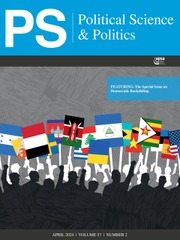Article contents
Teaching the Scientific Method in the Active LearningClassroom
Published online by Cambridge University Press: 14 July 2006
Extract
Undergraduate classroom presentations of the scientific method in thesocial sciences usually involve a lecture on the nature of thescientific enterprise: the discovery of the “truth” (if such a thingeven exists) about the relationship between some set of concepts,events, or phenomena by means of generating falsifiable hypothesesand testing them against data. The tendency of faculty, howeverunderstandable, to convert the presentation into an abstractdiscussion of the philosophy of science often obscures the basicissues for students. I present here a simple, active learningclassroom exercise which sensitizes students to the difficulties ofhypothesizing about and testing unobservable phenomena by appealingto students' intuitive understanding of the nature of knowledge andreality. I first describe the purposes and objectives of theactivity in more detail, then discuss implementing this specificactivity. Suggestions for activity adaptation and development byother instructors follow, and a brief discussion of sources andresources concludes.
Information
- Type
- THE TEACHER
- Information
- Copyright
- © 2006 The American Political Science Association
References
- 4
- Cited by

